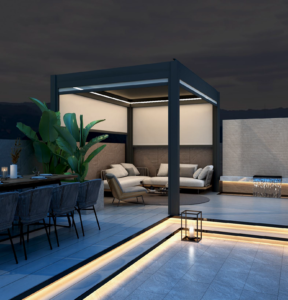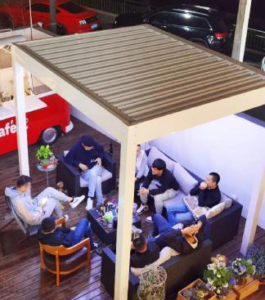
Is it cheaper to build a pergola or buy one?
Is it cheaper to build a pergola or buy one? Struggling to decide between DIY construction and pre-built pergolas? Building your own typically costs 40-60%
Curtain wall systems are an integral part of modern architecture, combining aesthetics with functionality to create sleek and visually appealing building exteriors. These non-structural systems play a critical role in enhancing energy efficiency, environmental performance, and occupant comfort. This blog will explore the basics of curtain wall systems and highlight their key design features.

A curtain wall system is a lightweight, non-load-bearing facade that hangs (like a curtain) on the structural framework of a building. Unlike traditional walls, curtain walls do not support the building’s weight. Instead, they transfer their loads, such as wind pressure or seismic forces, to the primary structure.
Curtain walls are typically made from aluminum frames filled with glass, metal panels, or stone veneers. Their primary purpose is to protect the building’s interior from external elements while maintaining a visually seamless and modern appearance.
Curtain walls can be classified into two main types:
Stick System
Unitized System
Curtain walls are designed to improve a building’s energy efficiency. Insulated glazing and thermal breaks within aluminum frames help minimize heat transfer, maintaining indoor comfort while reducing energy costs.
Although non-load-bearing, curtain walls must withstand external forces such as wind, snow, and seismic activity. Proper anchoring and material selection are critical to ensuring safety and durability.
Curtain walls act as a shield against rain, wind, and temperature fluctuations. Advanced sealing techniques and drainage systems prevent water infiltration and condensation.
Available in various materials, finishes, and designs, curtain walls enhance a building’s visual appeal. Architects can incorporate patterns, colors, and textures to reflect the desired style.
With extensive use of glass, curtain walls maximize natural light, reducing reliance on artificial lighting and improving occupants’ productivity and well-being.
Modern curtain walls can include acoustic insulation to reduce noise transmission, ensuring a quieter indoor environment.
Curtain wall systems are more than just an exterior cladding; they are an essential feature of modern architecture. By combining aesthetics with functionality, they create energy-efficient, visually striking, and durable buildings. Understanding their basics and key design features is crucial for architects, engineers, and building owners looking to optimize their projects.
Whether you’re designing a commercial skyscraper or a smaller structure, curtain wall systems offer unparalleled flexibility and performance, making them a go-to choice for innovative architectural designs.

Is it cheaper to build a pergola or buy one? Struggling to decide between DIY construction and pre-built pergolas? Building your own typically costs 40-60%

What is the difference between curtain wall and cladding? Installing an exterior building envelope and confused about these two systems? Curtain walls are structural glazing

How can I build a pergola? Want to add shade and style to your backyard without professional help? Building a basic 10’x10′ pergola takes 1-2

Worried your beautiful aluminum pergola might sound like a drum solo during storms? Modern aluminum pergolas produce minimal rain noise – typically 40-50 decibels (about

Looking for a durable, weatherproof facade solution for your building? Modern curtain walls must meet five essential requirements: structural integrity, weather resistance, thermal performance, fire

Considering an aluminum pergola but unsure about the investment? Aluminum pergolas range from $3,500 for basic 10×10 models to $15,000+ for large, high-end systems with
Before contacting suppliers, it’s essential to determine the exact specifications of the windows and doors you need. This includes:
The more detailed you are, the easier it will be for suppliers to provide accurate quotes and product options.
China has a vast manufacturing industry, so it’s crucial to find reliable suppliers who can deliver quality products on time. Here’s how to start your search:
Consider factors like the supplier’s reputation, certifications, and product quality. It’s also wise to work with suppliers who are accustomed to exporting to your region, as they’ll be familiar with international standards and shipping requirements.
Before placing a large order, request samples. Samples give you a chance to assess the quality firsthand and confirm that it meets your standards. Be prepared to cover the costs of samples and shipping, but consider it an investment in ensuring you’re working with a trustworthy supplier.
When reviewing samples, pay attention to:
Once you’ve selected a supplier, it’s time to negotiate terms. Most suppliers expect some level of bargaining, especially for larger orders. Important aspects to discuss include:
Quality assurance is crucial, especially when importing from abroad. Consider these inspection steps:
Importing windows and doors involves managing shipping logistics and navigating customs procedures. Here are some key factors:
After confirming quality, shipping terms, and pricing, you can place your order. Ensure that:
When the products arrive, inspect them thoroughly. Ensure there’s no damage from transit, and verify that everything matches your specifications. If there are any issues, address them with the supplier immediately.